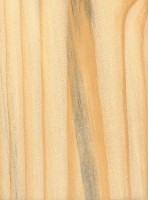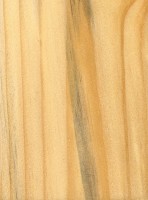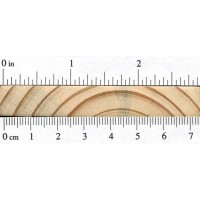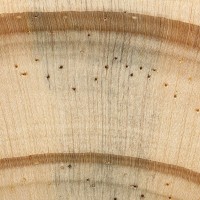 |
Common Name(s): Loblolly Pine
Scientific Name: Pinus taeda Distribution: Southeastern United States, though also widely grown on plantations Tree Size: 100-115 ft (30-35 m) tall, 1.5-5 ft (.4-1.5 m) trunk diameter Average Dried Weight: 35 lbs/ft3 (570 kg/m3) Specific Gravity (Basic, 12% MC): .47, .57 Janka Hardness: 690 lbf (3,070 N) Modulus of Rupture: 12,800 lbf/in2 (88.3 MPa) Elastic Modulus: 1,790,000 lbf/in2 (12.30 GPa) Crushing Strength: 7,130 lbf/in2 (49.2 MPa) Shrinkage:Radial: 4.8%, Tangential: 7.4%, Volumetric: 12.3%, T/R Ratio: 1.5 |
Color/Appearance: Heartwood is reddish brown, sapwood is yellowish white.
Grain/Texture: Straight grained with a fine to medium texture.
Endgrain: Large resin canals, numerous and evenly distributed, mostly solitary ; earlywood to latewood transition abrupt, color contrast high; tracheid diameter medium-large.
Rot Resistance: The heartwood is rated as moderate to low in decay resistance.
Workability: Overall, Loblolly Pine works fairly well with most tools, and it glues and finishes well.
Odor: No characteristic odor.
Allergies/Toxicity: Working with pine has been reported to cause allergic skin reactions and/or asthma-like symptoms in some people. See the articles Wood Allergies and Toxicity and Wood Dust Safety for more information.
Pricing/Availability: Should be widely available as construction lumber for a modest price.
Sustainability: This wood species is not listed in the CITES Appendices, and is reported by the IUCN as being a species of least concern.
Common Uses: Loblolly Pine is commonly used for construction, such as: stringers, roof trusses, poles, joists, piles; as well as interior applications such as subflooring and sheathing. In exterior applications, it is usually pressure-treated with preservatives.
Comments: Loblolly Pine is considered to be in the group of southern yellow pines, and shares many characteristics with other species of this group (Longleaf, Shortleaf, and Slash Pine) such as being: hard, dense, and possessing an excellent strength-to-weight ratio.
- Austrian Pine (Pinus nigra)
- Caribbean Pine (Pinus caribaea)
- Eastern White Pine (Pinus strobus)
- Jack Pine (Pinus banksiana)
- Jeffrey Pine (Pinus jeffreyi)
- Khasi Pine (Pinus kesiya)
- Limber Pine (Pinus flexilis)
- Lodgepole Pine (Pinus contorta)
- Longleaf Pine (Pinus palustris)
- Maritime Pine (Pinus pinaster)
- Ocote Pine (Pinus oocarpa)
- Patula Pine (Pinus patula)
- Pinyon Pine (Pinus edulis)
- Pitch Pine (Pinus rigida)
- Pond Pine (Pinus serotina)
- Ponderosa Pine (Pinus ponderosa)
- Radiata Pine (Pinus radiata)
- Red Pine (Pinus resinosa)
- Sand Pine (Pinus clausa)
- Scots Pine (Pinus sylvestris)
- Shortleaf Pine (Pinus echinata)
- Slash Pine (Pinus elliottii)
- Spruce Pine (Pinus glabra)
- Sugar Pine (Pinus lambertiana)
- Sumatran Pine (Pinus merkusii)
- Table Mountain Pine (Pinus pungens)
- Western White Pine (Pinus monticola)
- Virginia Pine (Pinus virginiana)








Most of your Southern Yellow Pine lumber is Loblolly, especially if chemically treated. Technically, according to SPIB, the wood stamped SYP could be any one of four species: Loblolly, Shortleaf, Slash or Longleaf. If the piece is exceptionally dense and shows some heartwood, you might have Slash or if you’re lucky, Longleaf, once the source of all now legendary heart pine timbers which came from a vast monoculture forest which once spread all the way from roughly coastal Virginia to Texas. These trees are still seen in the south, and pretty easy to identify by form, needle length, cone etc.… Read more »
I had 6 acres of Loblolly pine trees in Bastrop that burned in the fire of 2011. My land should have been harvested long before the fire to allow new growth. The Feds wouldn’t allow us to clear any land “in case an extinct Houston toad was there”. They never found one Houston toad in 30 years anywhere around this area. The four year drought had killed 20% of my tall pines that turned into fires reaching 1800 degrees. We had no fire breaks either including none on both sides of the electrical power cables (this is what caused the… Read more »
John,
Sorry to hear you lost your loblollies. Really graceful trees. I have a few larger specimens (80’+) on one of my properties. I would harvest them, however I have a few 150 year old Osage Oranges I’d like to mill first. Look no further than Osage Orange if you are going for an indestructible tree!
Just went through the “lost pines” area of Bastrop this weekend, beautiful, but the land values are outrageous!
So typical…and on “your” land. In our area (the main peach tree counties) of SC, the state IMPORTED coyotes for deer culling due to peach damage, as the deer love peaches. Now we have virtually NO wildlife of any kind left (except possums, skunks, armadillos, and Barred Owls who prey on everything that is left, especially pets) over thousands of acres – no squirrels, no song birds, no foxes, few turkeys, not one Wood Duck – and hardly a whitetail left. A really brilliant move. The exploding coyote population loves it, though, as well as farmers’ calves, goats, young pigs,… Read more »
In South Louisiana we have abundant coyotes as well as foxes, racoons, possum, swamp rabbits, deer, etc., including a few species I never saw in all the years of my youth but now are a regular sight, like cormorants and ahingas, beavers, and even the odd river otter.
There seems to be some idea that this particular species hardens to some miracle hardness like steel although I tend to think it’s not a huge difference between it and other yellow pine species. Is this mostly myth or fact?
It is quite durable wood, however it isn’t that much different from any other type of yellow Pine. It’s reputation for hardness, strength, and durability probably came from people comparing it to the white pine commonly used as building material.
I work with reclaimed Southern Yellow Pine and this stuff is STRONG and hard. Big difference in my opinion